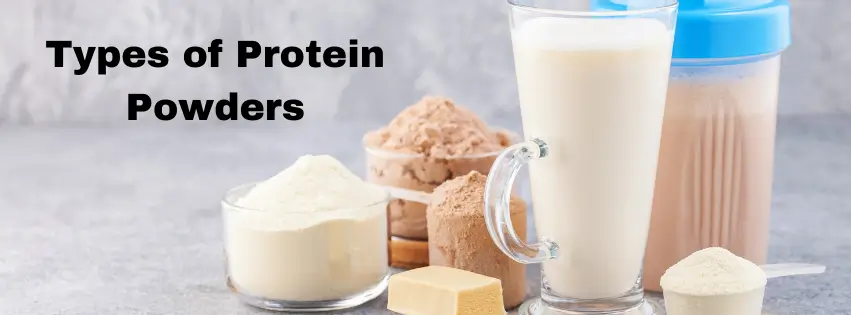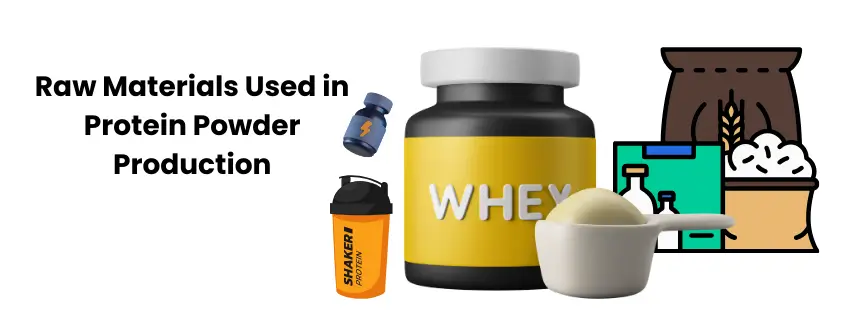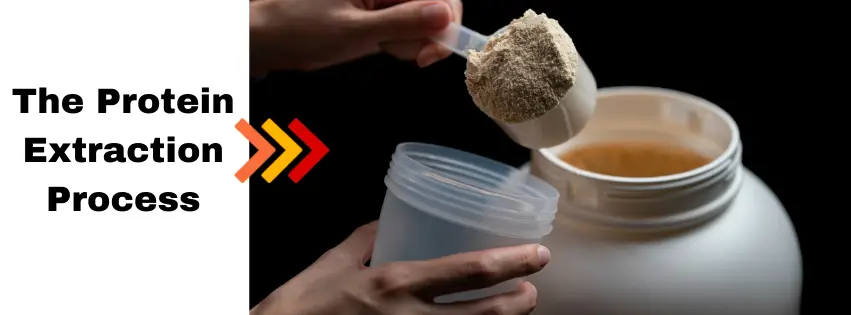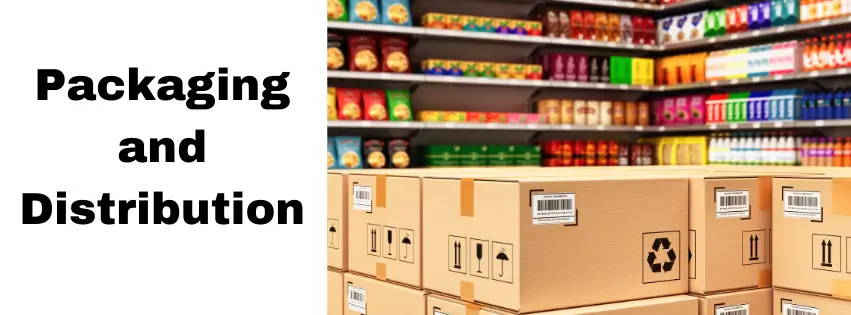Last updated on August 31st, 2024 at 04:26 pm
Table of Contents
Protein powder is a popular supplement. Whether for fitness enthusiasts or people just looking to add more protein to their diet, it’s widely used. But have you ever wondered, how is protein powder made?
Understanding the process can help you appreciate what goes into that scoop of powder you mix into your shakes. This guide will walk you through the entire production process, from raw materials to the final product.
Types of Protein Powders

Before diving into the manufacturing process, it’s important to know that not all protein powders are the same. There are different types, each with its own unique source and process of production.
A. Whey Protein
Whey protein is perhaps the most popular type. It comes from milk. When milk is turned into cheese, whey is the liquid that separates from the curds. This liquid is rich in protein. Whey protein is known for its fast absorption and is favored by athletes for muscle recovery.
B. Plant-Based Protein
Plant-based proteins are becoming more popular, especially among vegans and those with lactose intolerance. Common sources include soy, pea, hemp, and rice. Each of these sources has its own process of extraction and production.
C. Casein and Other Types
Casein is another milk-derived protein, but it’s absorbed more slowly than whey. This makes it a good option for a sustained protein release, often taken before bed.
There are also egg-based proteins and protein blends, which combine different sources for a broader amino acid profile.
Raw Materials Used in Protein Powder Production

The first step in making protein powder is selecting the right raw materials. These materials vary depending on the type of protein being produced.
A. Dairy-Based Proteins
Dairy-based proteins, such as whey and casein, start with milk. Milk from cows is the primary raw material. The quality of the milk is crucial because it affects the final product. The milk is tested for purity and fat content before it’s used in the protein extraction process.
B. Plant-Based Proteins
For plant-based proteins, the raw materials are plant sources like soybeans, peas, hemp seeds, and brown rice. These plants are grown, harvested, and cleaned.
The protein content in these plants is then extracted using various methods, which we will discuss later.
C. Additives and Flavors
In addition to the protein source, other ingredients are added to improve the taste, texture, and nutritional value of the protein powder. Common additives include sweeteners like stevia or sucralose, flavorings like vanilla or chocolate, and thickeners like xanthan gum. T
hese ingredients are carefully chosen to ensure they complement the protein and don’t detract from its nutritional value.
The Protein Extraction Process

The protein extraction process is where the raw materials are turned into a concentrated protein form that can be dried and powdered. This process varies depending on the protein source.
A. Filtration and Separation Techniques
For dairy-based proteins like whey and casein, the first step is to separate the protein from the rest of the milk components. This is done through a process called filtration.
The milk is passed through a series of fine filters that remove fats and sugars, leaving behind a concentrated protein liquid.
B. Concentration and Isolation of Protein
After filtration, the next step is to concentrate and isolate the protein. Whey protein, for example, can be concentrated into different forms, such as whey protein concentrate (WPC) or whey protein isolate (WPI).
WPC has a protein content of around 80%, while WPI has over 90%. The isolation process involves further filtering to remove even more fat and lactose, resulting in a purer protein product.
C. Enzymatic Processing and Hydrolysis
Some proteins undergo enzymatic processing, where enzymes break down the protein into smaller peptides. This process, known as hydrolysis, makes the protein easier to digest and quicker to absorb. Hydrolyzed protein is often used in specialized products for athletes or those with digestive issues.
Drying and Powderization Techniques

Once the protein has been extracted and concentrated, the next step is to turn it into a powder that can be easily packaged and consumed. This is done through drying and powderization techniques.
A. Spray Drying Process
Spray drying is the most common method used to dry protein. In this process, the liquid protein is sprayed into a chamber where it’s exposed to hot air.
The heat causes the water in the protein to evaporate, leaving behind fine protein particles that are collected as powder. Spray drying is efficient and produces a consistent, high-quality product.
B. Freeze-Drying Process
Freeze-drying is another method used, though it’s less common due to its higher cost. In freeze-drying, the liquid protein is first frozen, then placed in a vacuum.
The vacuum causes the frozen water in the protein to sublimate, or turn directly from ice into vapor. This method preserves more of the protein’s nutritional content but is more expensive.
C. Quality Control in Drying
During the drying process, it’s important to control the moisture content of the powder. Too much moisture can lead to clumping or spoilage, while too little can make the powder difficult to mix.
Manufacturers carefully monitor the drying process to ensure the final product has the right moisture content and consistency.
Quality Control and Testing

Quality control is a critical part of protein powder production. Ensuring that the product is safe, effective, and of high quality is essential.
A. Ensuring Purity and Potency
The purity and potency of protein powder are key factors in its quality. Manufacturers test the protein content to ensure it meets the label claims.
They also test for the presence of any unwanted contaminants, such as heavy metals or bacteria. These tests are conducted at various stages of production, from raw material sourcing to the final product.
B. Testing for Contaminants and Adulterants
Contaminant testing is especially important in protein powder production. Because the powder is often consumed by people with specific dietary needs, any contamination could have serious health implications.
Manufacturers test for a range of contaminants, including pesticides, heavy metals, and microbial contamination. They also test for adulterants, which are substances added to the product to falsely increase its protein content or weight.
C. Nutritional Analysis and Labeling
In addition to purity and contaminant testing, manufacturers conduct nutritional analysis to ensure the product meets its nutritional claims.
This includes testing for the presence of essential amino acids, vitamins, and minerals. The results of these tests are used to create the product’s nutritional label, which provides consumers with important information about the protein powder’s content.
Packaging and Distribution

Once the protein powder has been produced and tested, the final step is packaging and distribution.
A. Packaging for Shelf Life and Stability
Packaging plays a crucial role in the shelf life and stability of protein powder. The packaging must protect the powder from moisture, light, and air, all of which can degrade the product over time.
Common packaging materials include plastic containers, foil pouches, and glass jars. The packaging is also designed to be convenient for consumers, with features like resealable lids and easy-to-pour spouts.
B. Distribution Channels
After packaging, the protein powder is ready for distribution. Distribution channels can vary widely depending on the brand and target market. Some protein powders are sold directly to consumers through online platforms, while others are distributed to retailers like grocery stores, health food stores, and gyms.
The distribution process involves careful coordination to ensure the product reaches consumers in the best possible condition.
C. Global Reach of Protein Powder Products
Protein powder is a global product, with consumers in nearly every country. This means that manufacturers must consider the logistics of global distribution, including shipping, customs, and regulatory compliance.
In some cases, the product may need to be reformulated or repackaged to meet the specific requirements of different countries.
FAQs of protein powder
How is protein powder made step by step?
Protein powder is made through several key steps:
Sourcing Raw Materials: The process begins with selecting high-quality protein sources like milk for whey protein or plant materials like soybeans for plant-based protein.
Extraction: The protein is extracted from the raw material using filtration or other methods to separate the protein from fats, sugars, and other components.
Concentration and Isolation: The extracted protein is concentrated or isolated to increase its protein content. This step may involve further filtration or enzymatic processes.
Drying: The concentrated protein is then dried, typically using spray drying, to turn it into a fine powder.
Quality Control: The protein powder undergoes rigorous testing for purity, potency, and safety, ensuring it meets quality standards.
Packaging: Finally, the protein powder is packaged in airtight containers to maintain freshness and stability before being distributed to consumers.
How is protein powder manufactured?
Protein powder is manufactured through a process that includes extraction, filtration, drying, and packaging. It starts with the raw protein source, which is processed to separate the protein from other components like fats and carbs.
The protein is then concentrated, dried into a powder, and packaged for distribution. Quality control is a critical part of manufacturing to ensure that the product is safe and meets nutritional standards.
How do they turn protein into a powder?
Turning protein into a powder involves drying the liquid protein concentrate. This is commonly done using a spray drying technique.
The liquid protein is sprayed into a chamber with hot air, which evaporates the water, leaving behind fine protein particles that form a powder. This method ensures that the protein is evenly dried and retains its nutritional value.
How is protein made in the factory?
In the factory, protein production begins with sourcing and preparing raw materials like milk or plants. The protein is extracted and purified through processes like filtration and enzymatic treatment.
After concentration, the protein is dried into a powder form using spray drying. The powder is then subjected to quality control tests before being packaged for distribution.
What is the main ingredient in protein powder?
The main ingredient in protein powder is the protein itself, which can come from various sources such as whey (derived from milk), casein, soy, pea, hemp, or other plant-based materials.
Depending on the type of protein powder, additional ingredients like flavorings, sweeteners, and thickeners may also be included.
Can I make my own protein powder?
es, you can make your own protein powder at home using natural ingredients. Common DIY protein powders are made by blending dried and ground nuts, seeds, grains, or legumes.
For example, you can use ingredients like almonds, chia seeds, and oats, then grind them into a fine powder. However, homemade protein powder might not be as concentrated as commercially produced versions.
Is protein powder very processed?
The degree of processing varies depending on the type of protein powder. Whey and casein proteins undergo processes like filtration, concentration, and drying, which are considered moderate levels of processing.
Plant-based proteins also require processing to extract and concentrate the protein. While these steps are necessary to create a high-quality product, some protein powders may also contain additives that increase the level of processing.
Is protein powder made naturally?
Protein powder can be made from natural ingredients, but the process itself involves some level of industrial processing. The base ingredients like milk, soy, or peas are natural, but they undergo processes such as filtration, drying, and sometimes flavoring.
There are “natural” protein powders on the market that minimize the use of artificial additives and focus on using whole, minimally processed ingredients.
How Herbalife protein powder is made?
Herbalife protein powder is made using a process similar to other protein powders. It typically involves sourcing high-quality protein ingredients like soy or whey, which are then extracted, concentrated, and dried into powder form.
Herbalife adds vitamins, minerals, and other nutrients to their protein powders to create a balanced nutritional profile. The final product undergoes rigorous quality control before packaging and distribution.
What ingredient can replace protein powder?
There are several whole food ingredients that can replace protein powder, depending on your dietary needs:
Greek Yogurt: High in protein and can be used in smoothies.
Cottage Cheese: Another dairy option that provides a good amount of protein.
Eggs: Rich in protein and versatile in cooking.
Nuts and Seeds: Almonds, chia seeds, and hemp seeds are great protein sources.
Legumes: Beans and lentils can be blended into smoothies or added to meals for a protein boost.
How do you make pure protein powder at home?
To make pure protein powder at home:
Choose a Protein Source: Select ingredients like raw nuts, seeds, or legumes.
Dry the Ingredients: Dehydrate the ingredients thoroughly to remove moisture.
Grind into Powder: Use a high-powered blender or food processor to grind the dried ingredients into a fine powder.
Store Properly: Keep your homemade protein powder in an airtight container in a cool, dry place to maintain its freshness.
Is protein powder safe?
Yes, protein powder is generally safe for most people when used as part of a balanced diet. However, it’s important to choose high-quality protein powders and avoid excessive consumption.
Some protein powders may contain added sugars, artificial ingredients, or contaminants, so it’s important to select reputable brands and read labels carefully.
Consulting with a healthcare provider before adding protein powder to your diet is advisable, especially if you have any health concerns.
What are the disadvantages of protein powder?
While protein powder can be beneficial, there are some potential disadvantages:
Overconsumption: Excessive protein intake can lead to digestive issues, kidney strain, and dehydration.
Artificial Ingredients: Some protein powders contain artificial sweeteners, flavors, and preservatives that may not be suitable for everyone.
Cost: High-quality protein powders can be expensive.
Allergies: Some people may be allergic to certain protein sources like whey or soy.
Nutrient Imbalance: Relying too much on protein powder can lead to an imbalance in your diet, potentially crowding out other important nutrients.
Is it OK to have protein powder every day?
Yes, it’s generally okay to have protein powder every day, especially if you need help meeting your protein intake goals.
However, it’s important to balance protein powder with whole foods that provide a range of nutrients. Moderation is key, and you should aim to get most of your protein from natural food sources like meat, fish, dairy, legumes, and nuts.
Is whey protein safe for the kidneys?
For most people, whey protein is safe and does not harm the kidneys when consumed in moderate amounts. However, individuals with pre-existing kidney conditions should be cautious about high protein intake, including whey protein, as it could potentially worsen their condition.
It’s always best to consult with a healthcare provider before starting any new supplement regimen, especially if you have any health concerns related to the kidneys.
Conclusion
So, how is protein powder made? As you’ve seen, the process is complex and involves multiple steps, from selecting the raw materials to packaging the final product.
The goal is to produce a protein powder that is pure, potent, and safe for consumption. Quality control is a key part of this process, ensuring that each batch meets the highest standards.
As the demand for protein powder continues to grow, manufacturers are constantly innovating to improve the production process and create new products that meet the evolving needs of consumers.
Understanding how protein powder is made gives you a better appreciation of the product and helps you make informed decisions about which protein powder is right for you.
Whether you’re looking for a whey protein to fuel your workouts or a plant-based protein to support a vegan lifestyle, you can be confident that a lot of care and expertise goes into making that scoop of powder you add to your shake.
And as the protein powder industry continues to evolve, we can expect to see even more advancements in production techniques, quality control, and product innovation. The future of protein powder is bright, and it’s an exciting time to be a part of this growing industry.




